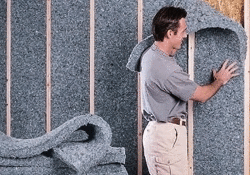Common Soundproofing Materials and products, ACOUSTICAL CONSULTANTS CONTRACTORS PRODUCTS DEALERS IN BANGALORE CHENNAI MUMBAI HYDERABAD

Common Soundproofing Materials and products, Acoustical Contractors and Products dealers imported from USA
Common Soundproofing Materials
1) Glass & Acrylic sheets
These two options work with same efficiency when the thicknesses are the same. The effectiveness is best when the thickness is around an inch or a little over 6 mm. Instead of using a material of higher thickness, it is better to have a sealed air gap between two sheets of the same material.
2) Plywood
Efficiency of plywood is not as good as drywall but is clearly stronger and less brittle. For plywood the most economic thickness is perhaps half inch or approximately 13 mm.
3) Drywall, Plasterboard or Gypsum board
The efficiency of drywall is not seen to improve considerably between thicknesses of 1/2 and 5/8th inch, so the most economic thickness is clearly half inch. When you apply many layers of drywall make sure to fix them using some kind of resilient fixing, which significantly improves the characteristics of soundproofing.
4) Fiberglass Reinforced Plastic Panels (FRP) and Mass Loaded Vinyl (MLV)
FRP and MLV are very effective products and can be easily used since their thickness is less than an inch. The drawback is that they are at times expensive. You can use FRP or MLV behind a second drywall layer to produce super soundproofing keeping the wall thickness almost the same.
5) Concrete Panel
This is not actually an option for majority of DIY-ers but if you are considering buying an apartment ensure the walls are minimum 4 inches of concrete and drywall or 6 inches of concrete suppose it is an incomplete surface. Six inches with drywall finishing must give you the similar soundproofing as a double brick and empty space construction.
6) Laminated Products
There is no reason for buying laminated products. For around the same expense, improved performance can be attained using the separate components mounted resiliently with a small cavity of air.
Do you require buying any special branded products? To this the answer is no. You will find plenty of advertisements for revolutionary scientific advances in soundproofing. There is a possibility that invention of something will be done one day that will be economical and highly effective however presently most branded products do not perform better than readily accessible combinations of economical materials.
A vital point on resilient channels:
Having mentioned that buying branded products is not needed, the resilient Channel is possibly one material that must be chosen more cautiously and which could be worth limiting to particular brands. You must look for a product ideally made from 25 gauge steel with S T C guarantee of some kind. Channels are supported on one or two legs and generally have cut outs or slits along their length. These are characteristics of design which complement to the material’s resilience.
When resilient furring channel is installed on a wall, if it is the kind having an open flange, flange must be facing upward so that from the frame it is slightly pulled out after attaching the wallboard. All the flanges must be pointed towards the same direction whether on a ceiling or wall. Take immense care when the wallboard is installed to the channels in order that you don’t "short out" the channel by screwing too much distant through the channel and to the inside of the timber behind.
If you want to soundproof your home or workplace you can contact Interior Game.